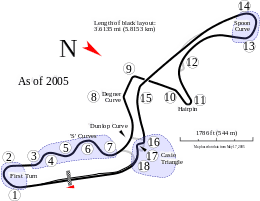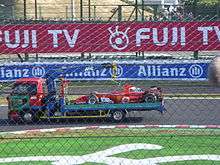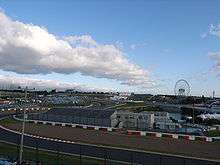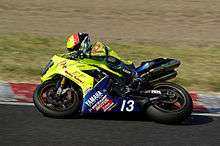Suzuka Circuit
 | |
| Location | Suzuka, Mie Prefecture, Japan |
|---|---|
| Time zone | GMT +9 |
| Coordinates | 34°50′35″N 136°32′26″E / 34.84306°N 136.54056°ECoordinates: 34°50′35″N 136°32′26″E / 34.84306°N 136.54056°E |
| Capacity | 155,000[1] |
| Owner | Honda Motor Co., Ltd. |
| Operator | Mobilityland Corporation |
| Opened | 1962 |
| Architect | John Hugenholtz[2][3][4][5] |
| Major events |
Japanese Grand Prix Suzuka 8 Hours WTCC Super GT Super Formula MJF Superbike D1 Grand Prix Super Taikyu |
| Grand Prix circuit (2003–) | |
| Length | 5.807 km (3.609 mi) |
| Turns | 17 |
| Lap record |
1:31.540 ( |
| Motorcycle Grand Prix circuit (2004–) | |
| Length | 5.821 km (3.617 mi) |
| Turns | 17 |
| Lap record |
2:07.110[6] ( |
| East circuit | |
| Length | 2.243 km (1.394 mi) |
| Turns | 7 |
| Lap record |
0:53.885 ( |
| West circuit | |
| Length | 3.466 km (2.154 mi) |
| Turns | 9 |
| Original circuit (1962–1982) (without final chicane) | |
| Length | 6.004 km (3.728 mi) |
| Turns | 17 |
| Lap record |
1:34.247 ( |
The Suzuka International Racing Course[7] (official name), Suzuka Circuit (鈴鹿サーキット Suzuka Sākitto) for short, is a motorsport race track located in Ino, Suzuka City, Mie Prefecture, Japan and operated by Mobilityland Corporation, a subsidiary of Honda Motor Co., Ltd.. It has a capacity of 155,000.
Introduction
Soichiro Honda decided to develop a new permanent circuit in Mie prefecture in the late 1950s. Designed as a Honda test track in 1962 by Dutchman John "Hans" Hugenholtz, Suzuka is one of few circuits in the world to have a "figure eight" layout, with the 1.2 km back straight passing over the front section by means of an overpass.
The circuit has been modified four times:
In 1983 a chicane was put at the last curve to slow the cars into the pit straight and the Degner curve was made into two corners instead of one long curve; the circuit was also made considerably safer in 1983 by adding more crash barriers, more run-off areas and removing straw bales leading into vegetation;
In 2002, the chicane was slightly modified, 130R (marked as 15 on the diagram) was also modified and some of the snake curves were made a bit straighter and faster;
In 2003, the chicane was made slightly faster and closer to the 130R.[8]
Following the fatality at the 2003 MotoGP round, Suzuka reconfigured the motorcycle variant of what is now known as the Hitachi Automotive Systems Chicane before the final turn, and added a second chicane, between the hairpin and 200R.[9]
The circuit can be used in five configurations; the car full circuit, the motorcycle full circuit, the "Suzuka east," "Suzuka west car," and "Suzuka west motorcycle" configurations. The "east" portion of the course consists of the pit straight to the first half of the Dunlop curve (turn seven), before leading back to the pit straight via a tight right-hander. The "west" course is made up of the other part of the full circuit, including the crossover bridge; the straight leading to the overpass is used for the start/finish line and the grid. The chicane between the hairpin and 200R separates the west and full course sections between cars and motorcycles.
The Degner curve was named in honour of Ernst Degner after he crashed his factory Suzuki 50 there during Suzuka's inaugural All Japan Championship Road Race meeting on 3 November 1962.
Motorsport events
Suzuka, openly touted by F1 drivers and fans as one of the most enjoyed, is also one of the oldest remaining tracks of the Formula One World Championship, and so has a long history of races as venue of the Japanese Grand Prix. Its traditional role as one of the last Grands Prix of the season means numerous world championships have been decided at the track.

Suzuka was dropped from the Formula One calendar for the 2007 and 2008 seasons in favour of the Toyota-owned Fuji Speedway, after the latter underwent a transformation and redesign by circuit designer Hermann Tilke. Suzuka and Fuji were to alternate hosting the Japanese Grand Prix from 2009. However, after Fuji announced on July 2009 that it would no longer be part of the F1 calendar,[10][11] Suzuka signed a deal to host the Japanese Grand Prix in 2009, 2010 and 2011.[12]
The circuit closed for a year in order for the renovation to make it F1-compliant for 2009, with the last major event held on November 18, 2007,[13] although some annual events (for instance, the Suzuka 8 Hours and Suzuka 1000km) were still held. The track held a re-opening day on April 12, 2009.
Suzuka also hosts other motorsport events including the Suzuka 1000km endurance race. Previously a part of multiple GT racing series including the now defunct group C class of the All Japan Sports Prototype Championship, the Suzuka 1000 km as of 2006 is now a points round of the Super GT Series, and is the only race of such length in that series. In 2010, the GT500 pole position time was 1:55.237. In 2007, the GT300 pole position time was 2:06.838.

Another major motorsport event is the Suzuka 8 Hours for motorcycles, which has been run since 1978. This event usually attracts big name riders and with the exception of 2005, due to the importance of the major manufacturers' involvement, the FIM ensures that no motorcycle races clash on the date.
NASCAR organized the NASCAR Thunder 100, a pair of exhibition 100-lap races on the east circuit, a 1.4 miles (2.3 km) layout which utilizes the pit straight and esses, before rejoining the main circuit near the Casio triangle. The cars were Sprint Cup Series and Camping World West Series cars and the field was by invitation for the two races, run after the 1996 and 1997 seasons. The 1996 event was marred by tragedy when during practice, pace car driver Elmo Langley died of a heart attack in the Chevrolet Corvette pace car at the esses during an evaluation run. The pole position speed was 83.079 miles per hour (133.703 km/h).[14] During qualifying for the 1997 race, rain caused Goodyear to use rain tires on Sprint Cup cars for the first time in the modern era.
It was announced on June 21, 2010 that the east section of the Suzuka Circuit would host the Japan round of the 2011 WTCC season instead of the Okayama International Circuit.[15] At the 2012 event, the pole position time was 52.885 seconds, for an average speed of 94.875 miles per hour (152.687 km/h).[16]
130R
Following two tremendous accidents in 2002 and 2003, safety has been a concern at the circuit's 130R, a 130 metres (427 ft) radius turn starting past the crossover which has been compared to Spa's Blanchimont, by Sky Sports commentator David Croft during the 2015 race. In 2002, Toyota F1 driver Allan McNish suffered a high-speed crash through the bump, which sent him through a metal fence; he was not seriously injured.

Track officials revised the 130R, redesigning it as a double-apex section, one with an 85 metres (279 ft) radius, and then a second featuring a 340 metres (1,115 ft) radius, leading to a much closer Casio triangle (chicane), with the chicane becoming a "bus stop" type for motorcycles.
However, the problem continued for the new revised section. During the 2003 MotoGP Grand Prix of Japan, the track's first major event since the revisions, MotoGP rider Daijiro Kato was killed when he crashed in the new section, on his way to the braking zone for the Casio triangle. MotoGP has not returned to Suzuka since the incident.
Popular culture

Along with Fuji Speedway, the Suzuka Circuit was one of the four tracks featured in the video game Pole Position II (the first game featured only the Fuji track). Suzuka 8 Hours was released for the Super NES in 1993; the motorcycle variant of the race. The Suzuka Circuit was also featured in the Final Lap and the Ferrari F355 Challenge arcade games and video games such as Super Monaco GP (1989), Forza Motorsport 2, Forza Motorsport 3, Forza Motorsport 4, Gran Turismo 4, Gran Turismo 5 Prologue, Gran Turismo 5, Gran Turismo 6, iRacing, R: Racing Evolution, Shift 2 Unleashed, Le Mans 24 Hours, The Cycles, MotoGP 3, MotoGP 4, Tourist Trophy, Auto Modellista, Racing Battle: C1 Grand Prix, Real Racing 3, and as the final race in Taito's racing game Continental Circus. The circuit appears in most F1 games that have been published since 1987. The east course was featured in NASCAR 98. Also, Suzuka's famous Ferris wheel was paid homage in the "Big Forest Track" in Virtua Racing.
Presumably due to licensing issues, on Pole Position II, the track is referred to in the Namco Museum versions as the "Wonder Circuit" ("Orange Circuit" in Namco Museum: Virtual Arcade), after Namco's "Wonder" series of amusement parks, despite its logo appearing on the starter's box since 1983. Under the same issue the open source game TORCS also has the track renamed as "Wheel 2".
Deaths
See also
- Twin Ring Motegi, a Honda owned race track and oval, host to the FIM MotoGP Japanese Grand Prix
References
- ↑ "Suzuka International Racing Course". worldofstadiums.com. Retrieved 29 June 2016.
- ↑ "日本GPプレビュー (2006 Japanese Grand Prix preview)". Honda. Motor Co., Ltd. (in Japanese). Honda. Motor Co., Ltd. Retrieved 2016-04-16.
- ↑ "マイ・ワンダフルサーキット 第28回 (My Wonderful Circuit 28)". Hiroaki Iemura (in Japanese). Honda. Motor Co., Ltd. Retrieved 2016-04-16.
- ↑ "マイ・ワンダフルサーキットII 第5回 (My Wonderful Circuit II 5)". Hiroaki Iemura (in Japanese). Stinger. Retrieved 2016-04-16.
- ↑ "マイ・ワンダフルサーキットII 第6回 (My Wonderful Circuit II 6)". Hiroaki Iemura (in Japanese). Stinger. Retrieved 2016-04-16.
- ↑ "2009 All-Japan Road Race Championship, Round 2". motoracing-japan.com. Moto Racing Japan. Retrieved 2010-10-12.
- ↑ "Japan". formula1.com. Retrieved 29 June 2016.
- ↑ "Suzuka: new chicane and 130R". etracksonline.co.uk. e-Tracks. 2 February 2003. Retrieved 21 September 2011.
- ↑ "Suzuka Begins Latest Phase of Modifications". motogp.com. Dorna. 2 February 2004. Retrieved 25 July 2015.
- ↑ "The Official Formula 1 Website". Formula1.com. 2007-09-08. Retrieved 2012-10-06.
- ↑ "Fuji gives up F1 race". GPUpdate.net. 7 July 2009. Retrieved 1 February 2011.
- ↑ "Suzuka to keep race until 2011". GPUpdate.net. 24 August 2009. Retrieved 1 February 2011.
- ↑ Bradley, Charles (ed.) (August 2007). "Suzuka to close for a year". Autosport. 189 (6): 11.
- ↑ "1996 NASCAR Suzuka Thunder Special - Racing-Reference.info". racing-reference.info. Retrieved 29 June 2016.
- ↑ "FIA WTCC TO RACE AT SUZUKA IN 2011". fiawtcc.com. 2010-06-21. Retrieved 2010-07-20.
- ↑ Mills, Peter (20 October 2012). "Alain Menu claims pole as Chevrolet seals title". Autosport. Haymarket Publications. Retrieved 20 October 2012.
External links
| Wikimedia Commons has media related to Suzuka Circuit. |
- Suzuka Circuit
- Suzuka track map and circuit history at RacingCircuits.info
- Suzuka at the Formula 1 site
- Suzuka Circuit History and Statistics
- Suzuka Circuit on Google Maps (Current Formula 1 Tracks)
- Audio walkthrough of the track, for use with games
- BBC Sport Suzuka Circuit Guide